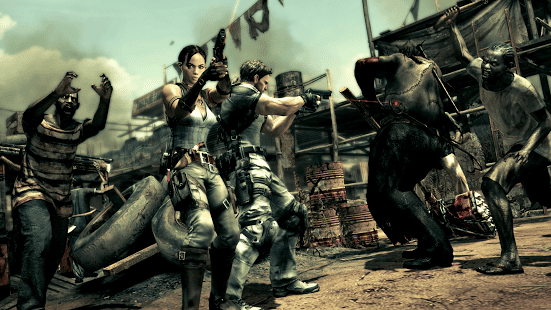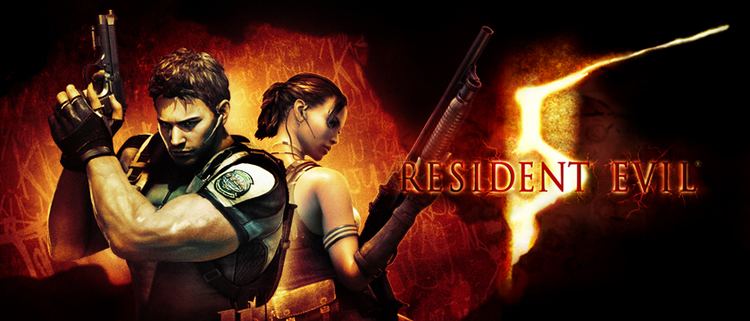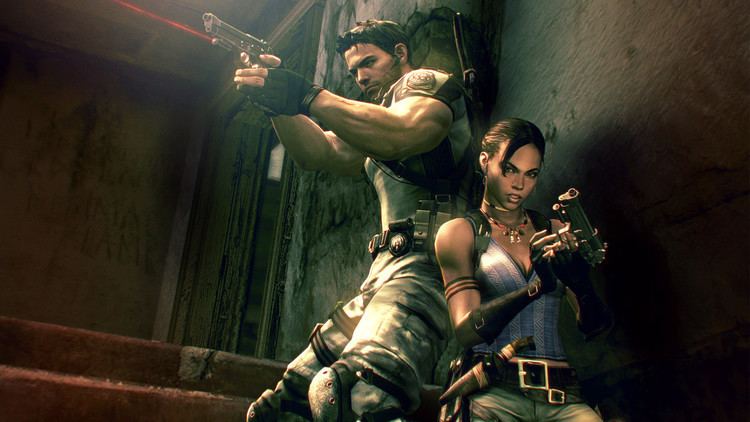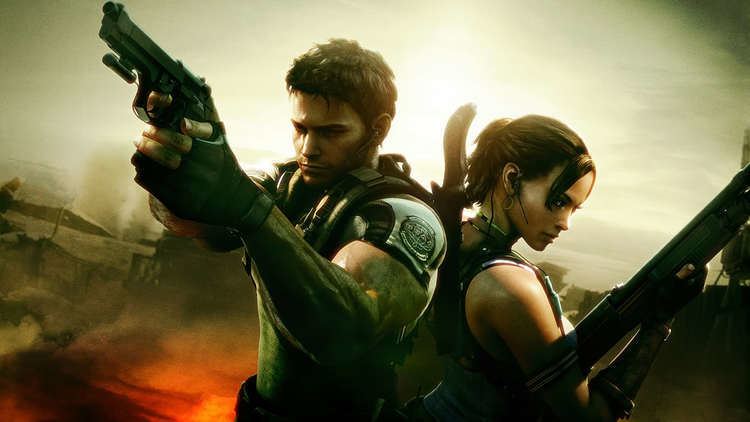8.5 /10 2 Votes8
9/10 IGN | 7.2/10 Play Mob Org 4/5 Google Play Initial release date 5 March 2009 | |||||||||||||||||||||||||||||||||
 | ||||||||||||||||||||||||||||||||||
Director(s) Kenichi UedaYasuhiro Anpo Writer(s) Haruo MurataYoshiaki HirabayashiTsukasa Takenaka Composer(s) Kota SuzukiAkihiko NaritaWataru Hokoyama Similar Resident Evil games, Capcom games, Survival horror games | ||||||||||||||||||||||||||||||||||
Resident evil 5 game movie all cutscenes 1080p hd
Resident Evil 5, known in Japan as Biohazard 5, is a third-person shooter video game developed and published by Capcom. The game is the seventh major installment in the Resident Evil series, and was first announced in 2005—the same year its predecessor Resident Evil 4 was released. Resident Evil 5 was released for the PlayStation 3 and Xbox 360 consoles in March 2009 and for Microsoft Windows in September of that year. The game's plot involves an investigation of a terrorist threat by Bioterrorism Security Assessment Alliance (BSAA) agents Chris Redfield and Sheva Alomar in Kijuju, a fictional region of Africa. Chris soon learns that he must confront his past in the form of an old enemy, Albert Wesker, and his former partner, Jill Valentine.
Contents
- Resident evil 5 game movie all cutscenes 1080p hd
- Resident evil 5 walkthrough part 1 veteran chapter 1 1
- Gameplay
- Plot
- Development
- Marketing and release
- Additional content
- Sales
- Critical response
- Allegations of racism
- References

The gameplay of Resident Evil 5 is similar to that of the previous installment, though it is the first game in the series designed for two-player cooperative gameplay. It has also been considered to be the first game in the main series to depart from the survival horror genre, with critics saying it had more resemblance to an action game. Motion capture was used for the game's cutscenes, and it was the first video game to use a virtual camera system. Several staff members from the original Resident Evil worked on Resident Evil 5.

Resident Evil 5 had a mostly positive reception, although it was criticized for problems with its controls. The game also received some initial complaints of racism, though an investigation by the British Board of Film Classification found such complaints were unsubstantiated. Resident Evil 5 was re-released for PlayStation 4 and Xbox One in June 2016. As of September 2016 it has sold over 7.1 million units, making it the franchise's best-selling individual game and also the best-selling Capcom game of all time. A sequel, Resident Evil 6, was released in 2012.

Resident evil 5 walkthrough part 1 veteran chapter 1 1
Gameplay

Resident Evil 5 is a third-person shooter with an over-the-shoulder perspective. Players can use a number of weapons including handguns, shotguns, automatic rifles, sniper rifles and grenade launchers, in addition to melee attacks. Players can make quick 180-degree turns to evade enemies. Many of the game's boss battles involve quick time events.

As in its predecessor Resident Evil 4, players can upgrade weapons with money and treasure and heal themselves with herbs, but cannot run and shoot at the same time. New features include infected enemies with guns and grenades, the ability to upgrade weapons at any time from the inventory screen without having to find a merchant, and the equipping of weapons and items in real time during gameplay. Each player can store nine items. Unlike the previous games, the item size is irrelevant; an herb or a grenade launcher each occupy one space, and four items may be assigned to the D-pad.
Resident Evil 5 is the first game in the Resident Evil series designed for two-player cooperative gameplay. The first player controls Chris Redfield, and a second player can control Sheva Alomar. If a person plays alone, Sheva is controlled by the game's artificial intelligence. When the game has been completed once, there is an option to make Sheva the primary character. Two-player mode is available online or split-screen with a local player. A second player joining a split-screen game in progress will make the game reload the last checkpoint; the second player joining an online game will have to wait until the first player reaches the next checkpoint, or restarts the previous one, to play. Split-screen mode presents the game in two windows with the wide-screen proportions of one-player mode, rather than splitting the screen in two, and the entire screen is not utilized. If one player has critical health, only their partner can resuscitate them; players will die if their partner cannot reach them. At certain points, players are deliberately separated during gameplay. Players can trade items during gameplay, although weapons cannot be traded with online players.
A version of the Mercenaries minigame which debuted in Resident Evil 3 is included in Resident Evil 5. This minigame places the player in an enclosed environment with a time limit. Customized weapons cannot be used and players must search for weapons, ammunition, and time bonuses while fighting a barrage of enemies, to score as many points as possible within the time limit. When the game was released the minigame multiplayer mode was offline only; a release-day patch needed to be downloaded to access the game's online multiplayer modes. Mercenaries is unlocked when the game's story mode has been completed.
Plot
Five years after the events of Resident Evil 4, Chris Redfield, a former Special Tactics and Rescue Service (STARS) member and now part of the Bioterrorism Security Assessment Alliance (BSAA), is dispatched to Kijuju in Africa. He and his new partner Sheva Alomar are tasked with apprehending Ricardo Irving before he can sell a bio-organic weapon (BOW) on the black market. When they arrive, they discover that the locals have been infected by the parasites Las Plagas (those infected are called "Majini") and the BSAA Alpha Team have been killed. Chris and Sheva are rescued by BSAA's Delta Team, which includes Sheva's mentor Josh Stone. In Josh's data Chris sees a photograph of Jill Valentine, his old partner, who has been presumed dead after a confrontation with Albert Wesker. Chris, Sheva and Delta Team close in on Irving, but he escapes with the aid of a hooded figure. Irving leaves documents that lead Chris and Sheva to marshy oilfields. This is where Irving's deal is to occur, but they discover that the documents are a diversion. When Chris and Sheva try to regroup with Delta Team, they find the team slaughtered by a BOW; Sheva cannot find Josh among the dead. Determined to learn if Jill is still alive, Chris does not report to headquarters.
Continuing through the marsh, they find Josh injured but safe and track down Irving's boat with his help. Irving injects himself with a variant of the Las Plagas parasite and mutates into a huge octopus-like beast. Chris and Sheva defeat him, and his dying words lead them to a nearby cave to learn more. The cave is the source of a flower used to create the Progenitor virus, which led to the creation of the T- and G-viruses, and has been used to form Uroboros, a new and powerful strain. Chris and Sheva find evidence that Tricell, the company funding the BSAA, took over a former Umbrella Corporation underground laboratory and continued Umbrella's research. In the facility, they discover thousands of capsules holding human test subjects. Although Chris finds that one of the capsules is Jill's, it is empty. When they leave, they discover that Tricell CEO Excella Gionne has been plotting with Wesker to launch missiles with the Uroboros virus across the globe; it is eventually revealed that Wesker hopes to take a chosen few from the chaos of infection and rule them, creating a new breed of humanity. Chris and Sheva pursue Excella, but are stopped by Wesker and the hooded figure, who is revealed to be a mind-controlled Jill. Excella and Wesker escape to a Tricell oil tanker; Chris and Sheva fight Jill, subduing her and removing the mind-control device before she orders Chris to follow Wesker.
Chris and Sheva board the tanker and encounter Excella, who escapes after dropping a case of syringes; Sheva keeps several. When Chris and Sheva reach the main deck, Wesker announces over the ship's intercom that he has betrayed and infected Excella with Uroboros. She mutates into a giant monster, which Chris and Sheva defeat. Jill radios in, telling Chris and Sheva that Wesker must take precise, regular doses of a virus to maintain his strength and speed; a larger or smaller dose would poison him. Sheva realizes that Excella's syringes are doses of the drug. Chris and Sheva follow Wesker to a bomber loaded with missiles containing the Uroboros virus, injecting him with additional doses. Wesker tries to escape on the bomber; Chris and Sheva disable it, making him crash-land in a volcano. Furious‚ Wesker exposes himself to Uroboros and chases Chris and Sheva through the volcano. They fight him, and the weakened Wesker falls into the lava before Chris and Sheva are rescued by a helicopter, which is piloted by Jill and Josh. As a dying Wesker attempts to drag the helicopter into the volcano, Chris and Sheva fire rocket-propelled grenades at Wesker, killing him. In the game's final cutscene, Chris wonders if the world is worth fighting for. Looking at Sheva and Jill, he decides to live in a world without fear.
Development
Resident Evil 5 was developed by Capcom and produced by Jun Takeuchi, who directed Onimusha: Warlords and produced Lost Planet: Extreme Condition. Keiji Inafune, promotional producer for Resident Evil 2 and executive producer of the PlayStation 2 version of Resident Evil 4, supervised the project. In February 2007, members of Capcom's Clover Studio were asked to help develop the game; many of the studio's developers instead worked on Resident Evil: The Umbrella Chronicles, which debuted for the Wii. Several staff members who worked on the original Resident Evil were involved in Resident Evil 5's development. The game's scenario was written by Haruo Murata and Yoshiaki Hirabayashi, based on a story idea by concept director Kenichi Ueda. Takeuchi announced that the game would retain the gameplay model introduced in Resident Evil 4, with "thematic tastes" from both Resident Evil 4 and the original Resident Evil. Tsukasa Takenaka provided additional story background and created the in-game files.
The decision for cooperative gameplay was made part-way through development, for a new experience in a Resident Evil game. Despite initial concern that a second player would dampen the game's tension and horror, it was later realized that a second player could increase tension in situations where one player had to be rescued. Takeuchi said that the decision to have both screens in their original 16:9 ratio in split-screen mode was influenced by a desire to avoid stacking the screens, which might be distracting, and the restriction on simultaneously moving and shooting was retained to increase player tension with the inability to move freely. Takeuchi cited the film Black Hawk Down and his experience working on Lost Planet: Extreme Condition as influences on Resident Evil 5.
Resident Evil 5 runs on version 1.4 of Capcom's MT Framework engine, with scenes recorded by motion capture. It was the first video game to use a virtual camera system, which allowed the developers to see character movements in real time as the motion-capture actors recorded. Actors Reuben Langdon, Karen Dyer and Ken Lally portrayed Chris Redfield, Sheva Alomar and Albert Wesker respectively.
Kota Suzuki was the game's principal composer, with additional music by Hideki Okugawa, Akihiko Narita and Seiko Kobuchi. The composer's electronic score includes 15 minutes of orchestral music, recorded at the Newman Scoring Stage of 20th Century Fox Studios in Los Angeles with the 103-piece Hollywood Studio Symphony. Additional orchestral music and the orchestral arrangements were by Wataru Hokoyama, who conducted the orchestra. Capcom recorded in Los Angeles because they wanted a Hollywood-style soundtrack to increase the game's cinematic value and global interest. Resident Evil 5's soundtrack features an original theme song, composed by Kota Suzuki and sung by Oulimata Niang.
Marketing and release
Resident Evil 5 was announced by Capcom on July 20, 2005, and the company showed a brief trailer for the game at E3 2007. Its full E3 trailer became available on the Xbox Live Marketplace and the PlayStation Store on July 26, 2007. A new trailer, shown at the Captivate 08 media summit, debuted on Spike TV's Gametrailers TV on May 31, 2008, and on the GameTrailers website. A playable game demo was released in Japan on December 5, 2008, for the Xbox 360, in North America and Europe for the Xbox 360 on January 26, 2009, and on February 2 for the PlayStation 3. Worldwide downloads of the demo exceeded four million for the two consoles, with over 1.8 million from January 26 to January 29.
On January 21, 2009, D+PAD Magazine reported that Resident Evil 5 would be released with limited-edition Xbox 360 box art; pictures of the limited-edition box claimed that it would allow two to sixteen players to play offline via System Link. Although Capcom said that their "box art isn't lying", the company did not provide details. Capcom soon issued another statement that the box-art information was incorrect, and System Link could support only two players. Microsoft released a limited-edition, red Xbox 360 Elite console which was sold with the game. The package included an exclusive Resident Evil theme for the Xbox 360 Dashboard and a voucher for Super Street Fighter II Turbo HD Remix from Xbox Live.
Resident Evil 5 was released for PlayStation 3 and Xbox 360 in March 2009, and Capcom released a dedicated Game Space on PlayStation Home. The space, Resident Evil 5 "Studio Lot" (Biohazard 5 "Film Studio" in Japan), had as its theme the in-game location of Kijuju. Its lounge offered Resident Evil 5-related items for sale, events and full game-launching support. Some areas of the space were available only to owners of Resident Evil 5. The space was released on March 5, 2009, in all PlayStation Home regions. A Microsoft Windows version was released in September 2009. This version, using Nvidia's 3D Vision technology through DirectX 10, includes additional costumes and a new mode in the Mercenaries minigame. Resident Evil 5 was re-released on Shield Android TV in May 2016, and was re-released on PlayStation 4 and Xbox One on June 28, 2016, with a physical disc copy following in America on July 12, 2016.
Additional content
Shortly before the release of Resident Evil 5, it was announced that a competitive multiplayer mode called Versus would be available for download in several weeks. Versus became available for download in Europe and North America on April 7, 2009, through the Xbox Live Marketplace and the PlayStation Store. Versus has two online game types: "Slayers", a point-based game challenging players to kill Majini, and "Survivors", where players hunt each other while dodging and attacking Majini. Both modes can be played by two-player teams. The Microsoft Windows version of Resident Evil 5 originally did not support downloadable content (DLC).
During Sony's press conference at the 2009 Tokyo Game Show Capcom announced that a special edition of the game, Biohazard 5: Alternative Edition, would be released in Japan for the PlayStation 3 in the spring of 2010. This edition supports the PlayStation Move accessory and includes a new scenario, "Lost in Nightmares", where Chris Redfield and Jill Valentine infiltrate one of Umbrella Corporation co-founder Oswell E. Spencer's estates in 2006. Another special edition of the game, Resident Evil 5: Gold Edition, was released for the Xbox 360 and PlayStation 3 in North America and Europe. Gold Edition includes "Lost in Nightmares" and another campaign-expansion episode, "Desperate Escape", where players control Josh Stone and Jill Valentine as they assist Chris and Sheva. The edition also includes the previously released Versus mode, four new costumes and an alternate Mercenaries mode with eight new playable characters, new items and maps. Like Alternative Edition, Gold Edition supports the PlayStation Move accessory with a patch released on September 14, 2010. The Xbox 360 version of Gold Edition came in a DVD with a token allowing free download of all DLC, while the PlayStation 3 version had all of the new content on a single Blu-ray disc. On November 5, 2012, Resident Evil 5: Gold Edition was placed on the PlayStation Network as a free download for PlayStation Plus users during that month.
As part of the game's conversion to Steamworks, Gold Edition was released for Microsoft Windows on March 26, 2015. Owners of the game from Steam or as a boxed retail Games For Windows Live can acquire a free Steamworks copy of the base game and purchase the new Gold Edition content. Capcom also confirmed a way around limitations in the Gold Edition release for Steamworks, which returns support for DirectX 10 and Nvidia 3D Vision, as seen in the Games for Windows Live version.
Sales
The PlayStation 3 version of Resident Evil 5 was the top-selling game in Japan in the two weeks following its release, with 319,590 copies sold. It was the fastest-selling game of the franchise in the United Kingdom, and the biggest Xbox 360 and PlayStation 3 game release in the country. By September 2016, Resident Evil 5 had sold 7.1 million copies worldwide between PlayStation 3, Xbox 360, and download, making it the best-selling Resident Evil game and the all-time best-selling Capcom game.
Critical response
Resident Evil 5 received positive reviews, and was nominated as Best Action Game at the 2009 IGN Game of the Year Awards. Although the game was praised for its graphics and gameplay, it was criticized for departing from the survival horror genre and for issues with its controls.
Reviewers praised the game's visuals and content. Corey Cohen of Official Xbox Magazine complimented the game's fast pace, and called the graphics "gorgeous". It was praised by Joe Juba and Mark Miller of Game Informer, who said that it had the best graphics of any game to date and that the music and voice acting helped bring the characters to life. Adam Sessler of X-Play said the game's graphics were exceptional, and Edge praised the gameplay as exhilarating and frantic. For IGN, Ryan Geddes wrote that the game had a surprisingly high replay value, and GameZone's Louis Bedigian said the game was "worth playing through twice in one weekend".
While still giving favorable reviews of the game, several reviewers considered it to be a departure from the survival horror genre, a decision they lamented. Chris Hudak of Game Revolution considered the game to be a "full-on action blockbuster" while Brian Crecente of Kotaku said about half way through the game it "dropp[ed] all pretense of being a survival horror title and unmask[ed] itself as an action shooter title. Kristan Reed of Eurogamer said the game "morphs what was a survival horror adventure into a survival horror shooter," and added that this attempt to appeal to action gamers would upset some of the series' fans.
Aspects of the game's control scheme were viewed negatively by critics. James Mielke of 1UP.com criticized several inconsistencies in the game, such as the ability to interact with objects and use cover. Mielke also criticized its controls, saying that aiming was too slow and noting the inability to strafe away from (or quickly jump back from) enemies. However, he concluded that despite the problems he found it was "still a very fun game". Kristan Reed also criticized aspects of the controls, such as the speed at which 180-degree turns were performed and difficulty accessing inventory. Joe Juba said that the inability to move and shoot at the same time seemed more "like a cheap and artificial way to increase difficulty than a technique to enhance tension."
Reception of the downloadable content was favorable. Steven Hopper of GameZone rated the "Lost in Nightmares" DLC eight out of ten: "Even though the episode is pretty short, there is some good replay value here and the added multiplayer elements are a nice touch. All in all, this is a worthy investment for fans of the original game." Samuel Claiborn of IGN rated the "Desperate Escape" DLC seven out of ten: "Despite Desperate Escape's well-crafted action sequences, I actually found myself missing the unique vibe of Lost in Nightmares. The dynamic between Jill and Josh isn't particularly thrilling, and the one-liners, banter and endearing kitsch are kept to a minimum."
Allegations of racism
Resident Evil 5's 2007 E3 trailer was criticized for depicting a white protagonist killing black enemies in a small African village. According to Newsweek editor N'Gai Croal, "There was a lot of imagery in that trailer that dovetailed with classic racist imagery", although he acknowledged that only the preview had been released. The second trailer for the game, released on May 31, 2008, revealed a more racially diverse group of enemies and the half-African BSAA agent Sheva, who assists the protagonist. Takeuchi denied that complaints about racism had any effect in altering the design of Resident Evil 5, saying that the game's producers were surprised by the controversy. In an interview with MTV, he said that Capcom's staff was racially diverse and acknowledged that different cultures may have had differing opinions about the trailer. In a Computer and Video Games interview, producer Masachika Kawata also addressed the issue: "We can't please everyone. We're in the entertainment business – we're not here to state our political opinion or anything like that. It's unfortunate that some people felt that way."
In Eurogamer's February 2009 preview of Resident Evil 5, Dan Whitehead expressed concern about controversy the game might generate: "It plays so blatantly into the old clichés of the dangerous 'dark continent' and the primitive lust of its inhabitants that you'd swear the game was written in the 1920s". Whitehead stated that these issues became more "outrageous and outdated" as the game progressed, and that the addition of the "light-skinned" Sheva just made the overall issue worse. Chris Hudak called the racism allegations "stupid": "If you are aware from the outset that the game takes place in Africa and yet you are still troubled by any skin-tone-related aspects ... there exists the possibility of simple, congenital retardation on your own part."
Wesley Yin-Poole of VideoGamer.com said that despite the controversy the game was attracting due to alleged racism, no expert opinion had been sought. He asked Glenn Bowman, senior lecturer in social anthropology at the University of Kent, whether he thought the game was racist. Bowman considered the racism accusations "silly", saying that the game had an anti-colonial theme and those complaining about the game's racism might be expressing an "inverted racism which says that you can't have scary people who are black." It was reported that one cutscene in the game scene showed "black men" dragging off a screaming white woman; according to Yin-Poole, the allegation was incorrect and the single man dragging the woman was "not obviously black". The scene was submitted to the British Board of Film Classification for evaluation. BBFC head of communications Sue Clark said, "There is only one man pulling the blonde woman in from the balcony [and he] is not black either. As the whole game is set in Africa it is hardly surprising that some of the characters are black ... we do take racism very seriously, but in this case there is no issue around racism."
